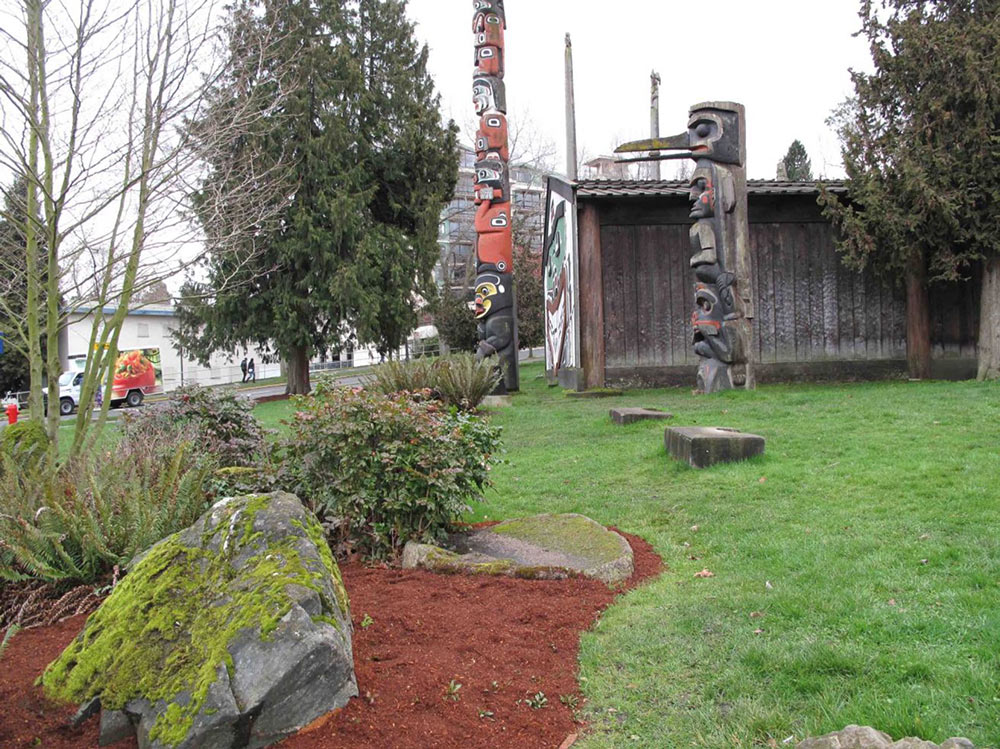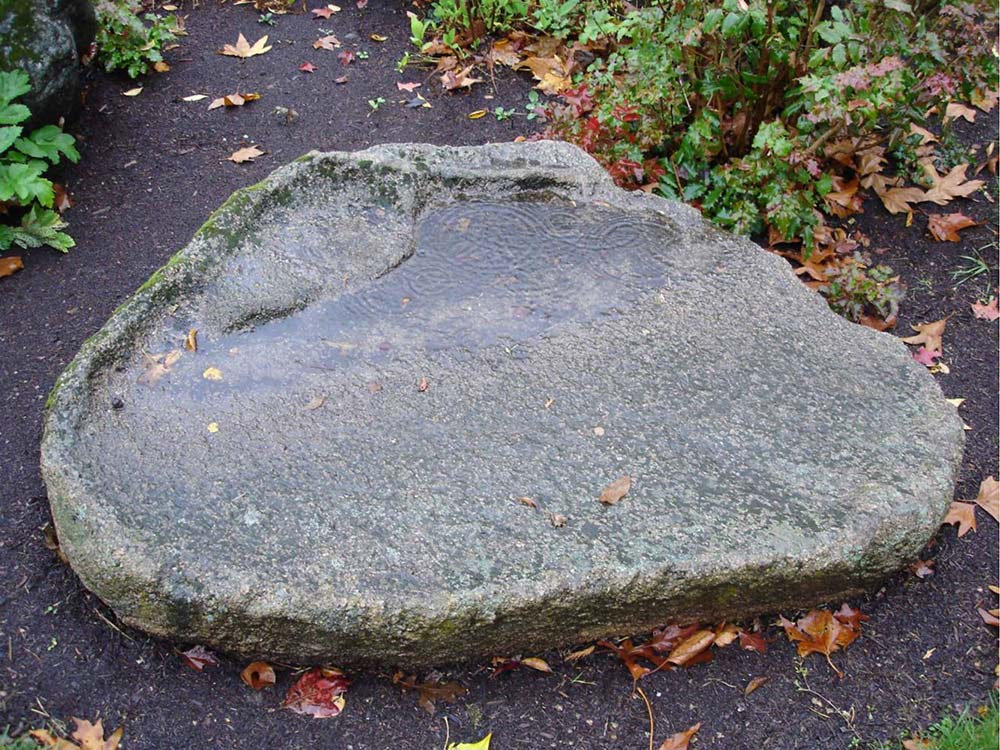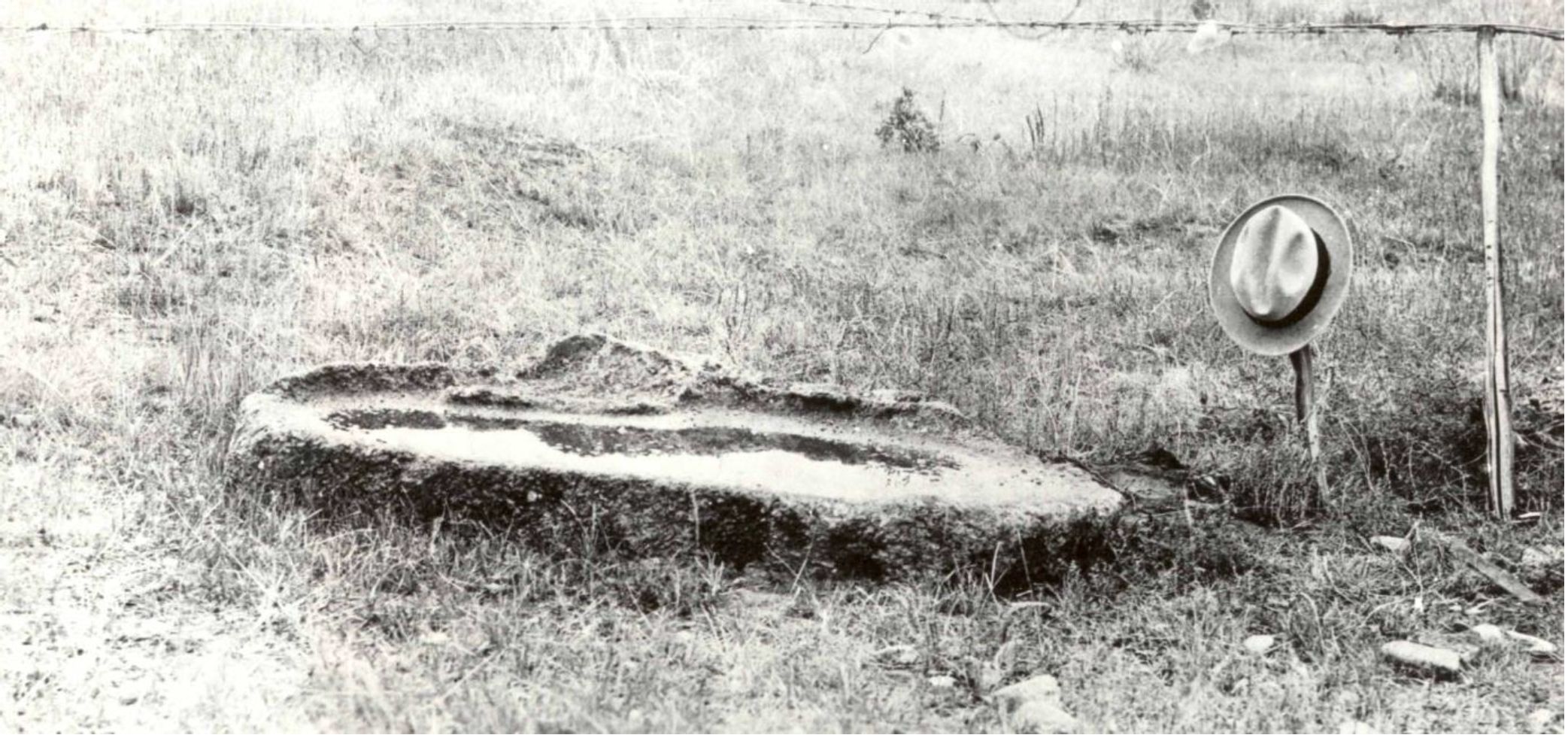By Grant Keddie. 22-02-2013.
Introduction
At the Royal B.C. Museum, in Victoria, British Columbia, a large natural stone with a shallow concave surface can be seen outside in the native plant garden near the North-East corner of Thunderbird Park (Figure 1 & 2).


This is a cultural object associated with First Nations that was once located south of Kamloops in the Southern Interior of British Columbia. The recorded details of its history are somewhat confusing.
The natural shallow depression on the top of the rock fills with water when it rains, often forming unique patterns on the surface of the water. One could speculate that it may have been used like a mirror (Figure 3).

During light rainfalls, unique patterns are formed on the surface of the collected water.
This large rock was moved from its former location, near the Museum’s old First Nations carving shed and placed in its present location in 2001.
The Written Record
This item is recorded in the Annual Report of the Provincial Museum for 1940, as “Large Stone mixing bowl from Tranquille” and donated by “P. Walker, Victoria”.
A photograph of it in more pristine condition is in our Anthropology photo collection as PN6919 (Figure 3). The PN6919 print has written on it “#15572 Archives Interior Salish Ceremonial bowl of granite”. The negative, which appeared to have been made from a photo in a scrapbook, with text underneath, includes part of the text: “Indian mixing bowl made out of granite rock 10m, S.W. Kamloops. (form of oyster shell) 125 years since Indians used it.
Weathering shows ….”

Figure 4, shows the rock in what might be its original position, with a propped-up barbed-wire fence running across it. I suspect P. Walker was a government official who arranged to bring the rock to Victoria.
There is an article in the Victoria Colonist on April 14, 1935 (page 6), about this rock titled: “Indian Mixing Bowl Shaped Like a Lake”, written by J. Scruton. It describes the rock as being “found within one mile of the Iron Mask Mine, southwest of Kamloops”. The article is a mixture of fantasy with some information that may be based on fact or invented recent legend. It is suggested that First Nations groups “periodically assembled around this bowl and settled their political differences with bone-point spears and tomahawks”. The article suggests that the rock was deliberately carved in the shape of an oyster and that it also is the same shape of the small alkali lake that it was found next to. The rock is, in fact, a natural rock that shows no evidence of being shaped other than more recent bangs from it being moved around. James Bunyan Munro (then Deputy Minister of Agriculture) became interested in the stone when he saw it filled with water after a rainstorm: “His investigations have revealed something of its history and secured for it a new location”. The rock had “just been transported” to the Tranquille Sanatorium near the time of the article.
The article states that before the rock was removed it “stood for around 125 years where the Indians positioned it, where it figured in intertribal conferences and squabbles, and was used for the pounding up of native grains, berries and pemmican”. The article claims “the bowl is a miniature reproduction of a small lake within a short distance of where the stone bowl stood so long”. A picture of the lake is shown with a picture of the rock.
An Article in The Daily Colonist newspaper of Victoria on August 13, 1935 entitled “Indian Relic At Tranquille. Massive Boulder, Hollowed Into Three Basins, Believed Used Long Ago” and A Vancouver Sun article of August 16, 1935 (p.2) titled “Huge Indian Relic” – which repeats the same information – records the rocks arrival at the Tranquille Sanitarium.
“On the lawn at Tranquille Sanitarium this week stands a grey granite stone weighting a ton and a half, believed to be one of the largest preserved relics of Indian civilization in British Columbia.
Discovered by John Bunyan Munro, Deputy Minister of Agriculture, some years ago, the stone was moved at his request to Tranquille from an unnamed alkali Lake, seven miles southwest of Kamloops.
The stone is hollowed into three compartments, including a large basin, believed to have been used for evaporating water to get native salts of the area used in fur preservation; and smaller basins in which pemmican may have been pounded.
Weighing 3600 pounds, the stone was too heavy to move to the B.C. Museum except at considerable cost. Mr. Munro said.”
What Can We Say About This Cultural Feature?
The 1935, Colonist article indicates that the original location of the large rock was within a mile of Iron Mask Mine. Iron Mask Mine is located at UTM 10 5614350 681220 and Latitude 50 39 17N and Longitude 120 26 11 W. An image of the lake shows its general shape to be oval with a small protrusion into the Lake at one end and hill on both sides in the background. This would make the most likely candidate for the location to be the small oval lake along the road located on the map in Lot 879 to the north-east of Ironmask Hill.
This location is within the Borden Unit area EdRc. (Archaeological sites are recorded according to a system of latitude and longitude developed by the late Dr. Charles Borden of the University of British Columbia). The most appropriate site number to give the large rock at this time would be EdRc-Y (The “Y” refers to the general locality and not to a specific site location). An on site comparison with the newspaper image of the lake and those in the general area will be necessary before a definite conclusion can be made as to the original location of the cultural rock.
We do know that First Nations of the Interior considered some of the isolated or unusually shaped boulders to be transformed people or animals of an earlier time. The people of this early world had animal characteristics. They were gifted in magic, and their children reached maturity in a few months. This time period ended with the coming of the transformer beings who changed some people into real animals and others, as well as animals, into rocks. Many of these boulders were connected to activities of the supernatural Coyote or a person called the Transformer. What is fact and what is fiction remains regarding the written history of this boulder uncertain.